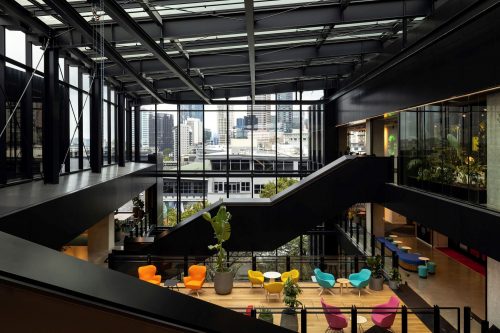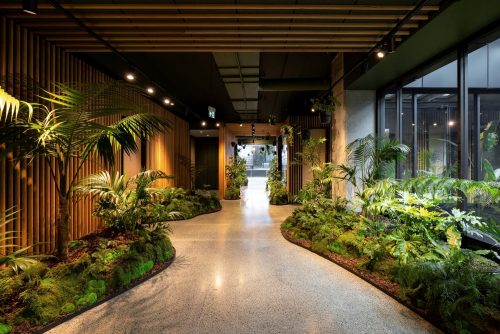Interior Design Lead, Anna Hill, and Registered Architect, Julian O’Neale of New Zealand based multi-disciplinary design practice Jasmax, offer their thoughts on emerging office design trends and how they see the workplace evolving in a post-pandemic world.
The pandemic has changed the way we work and how both landlords and occupiers think about the workplace. What are people now looking for in a workplace and how is this influencing office design?
The idea of the office construct has been changing for quite some time, this is nothing new, but the workplace is changing because the nature of work is changing. This is influenced by changes in technology, new generations, the idea of why we come to work and what our purpose is. More than ever we need to consider social, behavioural and environmental choices as we return back into the workplace. Work is an end to end experience, so what are people after?
- Connection: Social is crucial – people gain energy from one another and we need energy to prevent burnout. People want to return to the workplace for the social connection. Offices provide an inspiring space that enhances culture, mental health and productivity.
- Biophillic design: Nature reassures. Fostering a connection between people and nature within the built environment. A focus on interior spaces with direct visual connection to nature, good natural light, acoustics, air quality, natural materials and forms and of course planting.
- Flexibility: A one size approach to where and how people work does not fit all. Flexibility in experience is important in providing a variety of spaces where everyone can feel comfortable and productive
- Relationships: The benefits of getting people together should be celebrated. Face to face communication is critical and the workplace should enable this
- Familiarity: Old shoes wear best. Only change what is necessary
- Respite: Disconnect. Research proves that taking breaks positively impacts productivity and reduces health issues. Workplaces should include spaces that provide respite from the day to day tasks
Prioritising health & wellness in the workplace has never been more important. How are organisations adapting their fitouts to better meet the needs of occupiers in a post-pandemic world?
For many aspects of work, the past two years has accelerated a shift to a more people centric workplace. What the pandemic has taught us, is that the focus on health within our workplaces had been ignored for too long and changes need to be made to enable better and more attractive work environments for the future. So how are organisations adapting their fitouts to achieve this? By starting with an ethical examination of factors detrimental to wellness that have, until now, been accepted and ignored (e.g., the vast amounts of time spent in car commutes), we are seeing organizations begin to redefine their beliefs, policies and practices supporting when and how people work with the aim to facilitate greater wellness and effectiveness. As a result, ]we are no longer seeing sterile office environments in 50 shades of grey and rows of white desks, the workplace is focusing more on connecting people and supporting their wellbeing. Where wellness was something “nice to have,” it its becoming a “must have,” with residential inspired dwell spaces, break-out and staff hub zones that emulate the coolest café or restaurant space.
Biophilic design is something were hearing more and more about. What is this and how are organisations incorporating this into their office designs?
Humans have an innate connection to nature and being surrounded by nature supports our mental health. Biophilic design is the practice of this connection of people and nature within the built environment. So what are workplaces doing? It’s about evaluating the fitout to ensure there is connection to outdoor spaces, great natural air ventilation and light, the introduction of organic shapes and forms and of course, the addition of planting where possible. Small changes in the configuration of the interior environment can provide huge benefit to the health and wellness of the occupiers.
The office we once knew has changed for good. Over the next 5-10 years, how do you see workplace design evolving?
We’re trying to keep an open mind, the change over the last two years has been rapid but the realisation that collaborating virtually just isn’t the same as in person is very evident. Every employee being in the office all day, every day, might not be necessary in a lot of cases – but there is much to be lost when no one is ever together. Those in-person interactions are key to collaboration and creativity, to company loyalty and creating a sense of community.
What is evolving is not a single destination for work, but an ecosystem of spaces and places. Today’s employee operates in a variety of work modes, and technology enables that work to happen in any number of places. Creating a High-Performance Workplace means identifying those various modes and understanding work flows and organizational relationships to provide the best employee experience and support their work in ways that other options cannot. We are becoming more aware of our impact on the earth and wanting to reduce it, this is leading to many organisations to consider their operational carbon impacts from the performance of the buildings they inhabit to their buildings location and the transport choices it supports.
No one project is ever the same. Can you tell us about a design challenge you had with a project and how you overcame it?
We aim to start each project by getting an understanding of the first principles of why this project is happening, it’s not uncommon to find that a predetermined brief can have a lot of status quo bias built into it, seeking a deeper understanding of the problems our clients are trying to solve often allows more value to be extracted from the project than the original brief targeted.
Our interiors team has just completed MC’s new fitout in the MC Centre in Auckland. This was a unique brief, to expel all preconceived notions of the typical look and feel of a law firm; a space to celebrate contemporary Aotearoa and connect their people with the natural environment. How can we enhance the space and provide its inhabitants with an immediate connection to nature? Through design development the concept of a terrarium was formed, providing an experience akin to walking through the Waitākere Ranges. Located at the heart of the workplace, the terrarium provides staff with a space for contemplation and meeting for informal conversation, and to experience the calming and restorative effects of being immersed in nature throughout the working day. Drawing on holistic biophilic design principles, the terrarium includes 1,600 plants across a variety of species, including ferns and palms. The sensory experience is also enhanced by a change in environmental conditions; specifically, the ratio of oxygen in the air is artificially increased, the air is cooler, the lighting is subdued to replicate being beneath a tree canopy and sounds of the forest and New Zealand birdsong are played to provide a replication of the natural world.




